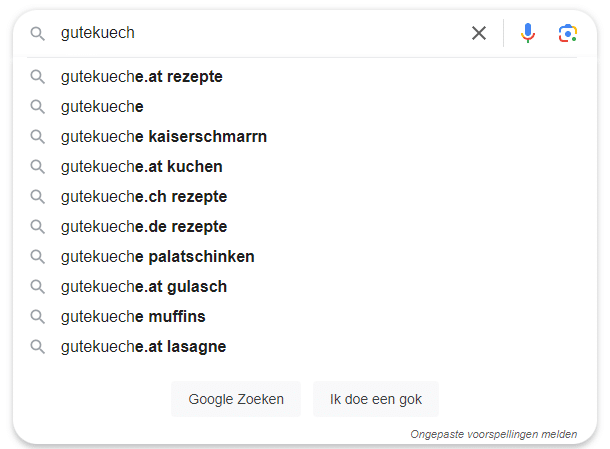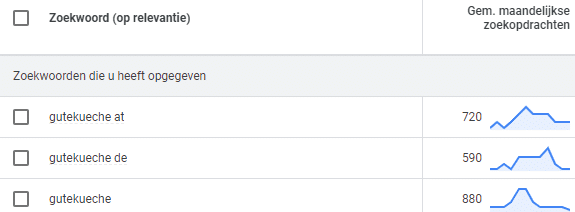How does Google deal with hreflang?
In a world where globalisation has long since ceased to be a new concept, the hreflang tag is a welcome and useful tool for international domains operating in different countries and/or languages.
Expertise SEO
By Anique Schoot

But at the same time, hreflang is, in Google’s own words, ‘one of the most complex aspects of SEO (if not the most complex one)’. So does it always go entirely according to plan? And does it always go wrong when you don’t set it up? We found out.
This is how Google uses hreflang tags
The hreflang tag is a piece of HTML in the website’s source code that tells the search engine which version of the website should be displayed in which region. With hreflang and country and language tags, you specify a website’s language and geographical target audience to avoid confusion for Google and incorrect search results as a result.
In this way, the attribute ensures that your French-language Website.fr is displayed in France, but that Website.de shows up for your German target group. Moreover, do you have several websites in the same language, each serving a different country – with perhaps just different culture? Then you can easily use the hreflang to indicate which (sub)domain targets Germany, which targets Austria and which targets Switzerland. A clever piece of SEO – in theory.
Case study: 25 international domains
In their own guidelines, Google recommends making the language and target audience of your web pages explicit in the hreflang, just to be on the safe side. So you might expect the search engine to take a (correctly) completed hreflang tag into consideration 100% of the time. Does it? And what happens if you do not add hreflang to your multilingual domain(s)?
To find out, we selected 25 major websites from different industries operating in multiple countries. We zoomed in on the search results in region Germany, and analysed the proportions within the search data over the course of 30 days for 8,000 German search terms for which these websites are indexed.
We look at the data from 2 angles:
- Which regional extensions and subdomains do we all come across in German search results over the course of 30 days?
- Which of the regional extensions or subdomains was dominant at the keyword level? In other words, which version of the website performed best (based on overall presence and average position) when more than 1 extension of the lot ranked for a keyword?
For this little study, we consider it successful when in ≥90% of the time or cases the German extension or subdomain of the website was displayed by Google.
Going international in Google: initial findings
With angle 1, we found no case without noise. For each of the 25 international websites, in addition to the German .de domain, one or more domains meant for other countries also appeared to a greater or lesser extent. However, in many cases things went pretty well: in 17 of the 25 cases, the German website was indexed in 90-99% of the snapshots.
Looking at the data from perspective 2, Google is actually doing quite well. For 23 out of 25 websites, the .de domain emerged as a clear – and justified – winner in the search results, representing a success rate of around 92%.
Hreflang in numbers
Time to see how these results compare with hreflang. Closer inspection reveals that 15 out of 25 international websites have a hreflang tag set, 60%. For these websites with hreflang, 100% of them are doing largely well: the German extension is the dominant search result in 90% or more cases. Good job, Google.
All the numbers:
|
German extension dominant 92% (23/25) |
Hreflang set 65% (15/23) |
|
No hreflang set 35% (8/23) |
|
|
German extension not dominant 8% (2/25) |
Hreflang set 0% (0/2) |
|
No hreflang set 100% (2/2) |
Deviating cases
For a number of websites, however, the results were surprisingly mixed. Recipe platform Cookidoo was visible in Germany with Cookidoo.de in only 35% of cases. The remaining time, no less than 13 other variants of the website appeared, including the Polish, English, Turkish and Austrian Cookidoo.
Looking at angle 2, Cookidoo.de wins out in a meager 51% of the other languages and versions, but there are still a fair number of keywords for which Cookidoo.pl, Cookidoo.com.tr, Cookidoo.co.uk and so on, come out on top. What is going on here?
Recipe competitor Gutekueche is another case in point. For this website, Gutekueche.de was more present than the domains of neighbouring Austria and Switzerland in only 20% of cases. The real winner here was Gutekueche.at, which performed better in the German SERP for a whopping 74% of keywords.
Do recipe websites happen to be tricky for Google, or is there more to it?
Gutekueche
The very first check we naturally do: has Gutekueche set a hreflang? This turns out not to be the case, which suddenly makes it a lot more understandable that the search engine is having trouble separating and assigning 3 same-language websites. Without a hreflang attribute that tells Google which German-language domain should be shown in which region, the search engine relies on other on-page and off-page signals for assessment.
We decide to take a look at Gutenkueche ourselves, and upon entering it in the search bar, we immediately notice that Google’s own search additions are also in favour of Gutekueche.at, at least in the Netherlands:

Something to do with the chicken and the egg? Looking at search volumes within Germany for both variants of the website, we see at least the same pattern. Keyword variants of ‘gutekueche.at’ have more search volume than variants of ‘gutekueche.de’:

Could it be that the Austrian version of Gutekueche had existed for longer and that this ‘OG’ is therefore more familiar to the German public? In any case, this is not apparent from the data, because for both .de and .at we find a first mention in 2001 in the Internet Archive. However, in our experience, search interest does play a role in Google’s assessment of a website, so it could be that the higher search volume of Gutekueche.at plays a role as a ranking factor.
A quick SEO check yields little. The look and feel of both websites is similar, and in terms of Core Web Vitals, they both perform excellently. At the same time, the website structure and metacontent do not seem to be optimal in either case either, so that is probably not where the difference in visibility will lie with Gutekueche.
Another ranking factor that may weigh heavily is domain authority: the relative strength of the backlink profile. Gutekueche.at appears to have a higher DR of 71, compared to Gutekueche.de with a DR of 60. In other words: .at receives quite a bit more external validation of quality and reliability than .de does.
It seems that this combination of greater search interest and higher authority is enough reason for Google to prioritise the Austrian domain – in the absence of guidelines in the hreflang – with the German public.
Cookidoo
Like the other recipe site, Cookidoo, as you might also expect with this result, does not appear to have set a hreflang. Like Gutekueche, something goes wrong international search results, but not the same thing.
Interestingly, there is no confusion for Google between extensions in the same language, but rather between regions that bear little resemblance to each other: in particular, Cookidoo Germany, Poland, the UK and Turkey are often dominant in search results. Let’s inspect this closer.
One logical explanation would be that in cases where Google favours a non-German extension, it is a recipe that does not appear on the German extension itself, forcing the search engine to swerve. Another explanation could be that these cases involve an ambiguous keyword; a keyword that does not appear to obviously be German, Polish, Turkish or even Italian dishes. Neither of these two explanations therefore seem to hold (consistently).
Domain authority does not seem to be a decisive factor with Cookidoo either, as Cookidoo.de has the highest DR of all competing extensions. The same applies to search volumes: variants of ‘cookidoo.de’ are by far the most frequently searched for in Germany.

To hreflang, or not to hreflang?
The tentative conclusions we can draw from this little survey:
- Setting hreflang is effective: 100% of the websites in our case that had a hreflang tag filled in went predominantly well in search results.
- At the same time, not setting hreflang is almost as effective. Even without giving Google extra handles with the hreflang, in 80% of the 25 examples it still works out as intended.
Do you own an international website and have not yet set up hreflang, but do you think it is important that the right region finds the right target group? Then maybe you should reconsider that choice if you recognise yourself in at least 1 of the points below:
- You have a recipe platform;
- You have not bothered to translate the content of your websites into the correct language;
- One of your domains is emphatically more popular, well-known or otherwise authoritative than the rest.
Google by no means always does what it says, but in the case of hreflang, we can say that our favourite search engine is functioning properly. Scientifically significant? No. Nice to know? As far as we are concerned, yes. Fun fact for the next SEO drinks party? Certainly!
Need help with hreflang?
Our specialists know how, and this also applies to all your other search questions. Feel free to request a brainstorm session, we would be happy to take a look at it with you.
